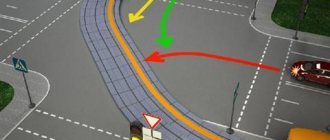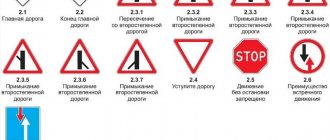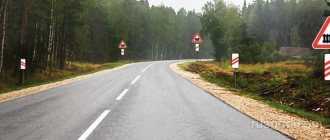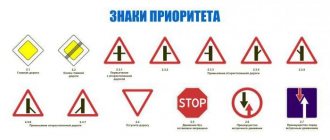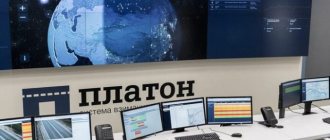Good afternoon, dear reader.
In the next article in the series “Rules for driving through intersections,” you will learn about the rules of the road that apply to uncontrolled equivalent intersections .
It is quite difficult to find such an intersection in a populated area. However, outside the city, equivalent intersections have become widespread, so every driver needs to clearly know how such intersections can be passed without violating traffic regulations.
I remind you that the driver must determine the type of intersection before the car enters that intersection. Previous articles in the series cover intersections:
- with a traffic controller;
- with traffic lights;
- unequal.
At first glance, it seems that the rules for driving through intersections are unreasonably complex, since dozens of different situations are possible. In fact, everything is quite simple, and if you spend a few minutes studying the previous articles in the series, you will not have any problems.
As for uncontrolled equivalent intersections, only a couple of points of traffic rules apply to them, and therefore they should not cause any difficulties. These rules will be discussed below:
- Signs of an equivalent intersection.
- Order of movement.
- Unsolvable situation at the crossroads.
Signs of an equivalent intersection
An intersection is equivalent if simultaneously met:
- no traffic lights or traffic controller;
- no priority signs (main road, give way, etc.);
- both intersecting roads have the same surface (hard or dirt).
Additionally, to indicate equivalence, road sign 1.6 “Equivalent intersection” can be used:
Note. The number of lanes and carriageways on roads does not affect the type of intersection.
T-junction
The main difference between a T-intersection and other types of similar sections is that there are fewer roads. The rules for driving through such intersections depend on what maneuver and in what direction the driver plans to make.
When driving through T-shaped intersections of equivalent roads, you must follow the rules:
- Compliance with the rule of skipping interference on the right.
- Accuracy in driving and attentiveness to the situation.
- Performing a maneuver at low speed to avoid unpleasant situations.
It is important to remember that an equivalent intersection is a place with a high level of danger and it is on such sections of the road that the largest number of accidents occur. When a driver does not act according to traffic rules, but based on his own desires, the risk of unpleasant situations increases several times.
Driving through intersections by such motorists is fraught with consequences for other road users that none of them can foresee.
By following simple rules you can minimize risks. The main thing when driving through an equivalent intersection is not just to rely on your own confidence in the correctness of your own skills and knowledge, but to be as careful as possible in your actions. This is the only way to prevent unpleasant situations from arising.
Tags: road means unequal
- Related Posts
- Rights and obligations of the bailiff
- Application for refund of state duty to the court, to the tax office: sample
- The procedure for debt collection by bailiffs
« Previous entry
Order of movement
Driving through equivalent intersections is regulated by two points of the traffic rules (13.11 and 13.12), the first of which applies to all maneuvers at the intersection, and the second - only to turning left and making a U-turn:
13.11. At the intersection of equivalent roads, with the exception of the case provided for in paragraph 13.111 of the Rules, the driver of a trackless vehicle is obliged to give way to vehicles approaching from the right. Tram drivers should follow the same rule among themselves.
13.12. When turning left or making a U-turn, the driver of a trackless vehicle is obliged to give way to vehicles moving on an equivalent road from the opposite direction straight or to the right. Tram drivers should follow the same rule among themselves.
Right turn
When making a right turn, the trajectory of the white car does not intersect with the trajectories of other cars, so this maneuver can be performed regardless of whether vehicles are approaching from other directions.
Go straight
When driving straight, the trajectory of the white car intersects with the trajectories of other cars. In this case, you should give way to an orange car that is approaching the intersection on the right.
Turn left or make a U-turn
Let me remind you that when making a left turn or a U-turn at an equivalent intersection, in addition to paragraph 13.11 of the rules, paragraph 13.12 also applies. Therefore, it is necessary to give way to both cars approaching from the right (regardless of which direction they are traveling) and to cars that are coming towards you and making a right turn or continuing to drive straight. Those. You should give way to both the orange and blue cars.
Please note that the trajectory of your car will not always intersect with the trajectories of the vehicles listed above, so not all cars need to give way.
For example, if multi-lane roads intersect at an intersection, then cars will be able to pass each other and their trajectories will not intersect.
What are equal and unequal roads?
Traffic inspectors never tire of repeating to all drivers, even those who already have a lot of driving experience, that in order to safely drive through this type of intersection, you need to be vigilant, as well as respect for all road users, and give way to pedestrians and those cars that have priority.
Absolutely all drivers must follow traffic rules and caution, especially when it comes to pedestrians. If we are talking about ordinary pedestrian crossings, everything is simpler. You need to brake in advance, you need to be vigilant, especially if a child has entered the crossing.
Two types of intersection can be found. The most common method is a crossroads, when two roads are placed perpendicular to one another.
Its essence is as follows: wherever the driver goes, he must pass vehicles located to his right, that is, an obstacle to the right.
You need to figure out who is missing and who is giving in instantly. Reducing speed will protect you from rash actions. Before the intersection of equivalent roads, sign 1.6 is installed; it is the main signal to slow down.
- upon approaching an equivalent intersection, the driver must change lanes to the rightmost lane;
- pedestrians, cyclists on the bike path, and buses will have to give way;
- the vehicle’s trajectory must adhere to the extreme right side and essentially not interfere with other vehicles’ maneuvers.
Also read: Transport tax for individuals in 2021 calculator
Driving through such an intersection must be done with caution, given that you can always meet a driver who has forgotten the rules or is confident that he is moving on the main road. When approaching an intersection of equal roads, remember that there is one rule common to everyone: if you have an equal right to cross the intersection first, you must use the “interference on the right” method.
Arthur, one is the main one, the other is secondary. . these are unequal) it can be an asphalt road in relation to a dirt road, or a road with a “main road” sign in relation to a road with a “give way” sign. equivalent - these are roads at the intersection of which the order of travel is determined either by the traffic controller or by the drivers themselves according to the rule “interference on the right”
Gennady 1. Equal roads - roads with the same surface Valery without priority signs Evgeny. 2. Unequal roads - with different surfaces Denis will always be the main one in relation to the dirt road). Unequal roads are also identified by priority signs: “Give way” means the road is of secondary importance. “road” is the main road, you have priority.
- Before turning right, you should make sure that no one is coming from the opposite direction in our direction, and also that the black car (on the right) is not about to turn around at the intersection.
- When moving straight or left, we will also give way to green and black cars, since they are driving along the main road.
- When turning at an intersection, we will have to give way to the blue car, because by performing this maneuver we will twist its right side.
- When turning right, we pass the intersection first.
- Also when driving through an intersection in the forward direction.
- We do not yield to anyone when turning left.
- And only when turning around will we have to give way to the vehicle on the left (blue car), because they are also driving along the main road and will be an obstacle for us on the right.
Driving school online
How do we understand this – an equivalent road at the crossroads of unequal roads?! The rules mean the following: both you and the tram are on the main road. Or both, you and the tram - on a secondary road. In this case, the tram moves either in the opposite direction or in the same direction.
What is characteristic of the intersection of unequal roads? Firstly, this is necessarily an unregulated intersection. There are no traffic controllers or traffic lights here. Or there are traffic lights, but they do not work or are switched to flashing yellow mode. And, secondly, one road is the main one, and the others (no matter how many there are) are secondary.
12 Jul 2021 stopurist 3537
Two types of intersection can be found. The most common method is a crossroads, when two roads are placed perpendicular to one another. How to determine the main road without signs Arthur: one is the main road, the second is a secondary one. Equivalent roads are roads with the same surface Valery without priority signs Evgeniy. Both are asphalt.
Dear readers! Our articles talk about typical ways to resolve legal issues, but each case is unique.
If you want to find out how to solve your particular problem, please use the online consultant form on the right or call the numbers provided on the website. It's fast and free!
- Equal and unequal roads are
- What is an equivalent and unequal road? Intersection of equivalent roads
- What does an uneven road mean?
- Equal and unequal roads
- What is an equivalent and unequal road?
- What do equal and unequal roads mean? How to understand an equivalent and unequal road
In previous articles, we examined traffic through intersections regulated by traffic lights or traffic controllers. In this article we will describe the procedure for driving through unregulated intersections.
If the car driving behind has already begun to overtake, you cannot interfere with it - it is better to slow down, let it overtake, and then calmly prepare to make the turn.
The article discusses a similar road situation. In the photo, the main road at the intersection changes direction to the right.
In this case, if you continue to move, it is mandatory to turn on the right turn signal!
I gave way to the vehicle on the left and entered the empty lane on the far side of the center line.
I glanced to the right at the absence of a vehicle, and at that time another car drove towards me from the oncoming secondary road with the intention of also turning left. And we collided. Who is guilty? Please judge us.
If I understood correctly, then you actually had a mutual left turn at the intersection, each in its own direction. But the passing failed, and the cars collided.
In my opinion, both drivers are at fault. Both turned left under equal conditions and rights. For example, as one of the options, talking on the phone at this moment. The inspector’s task is to put these nuances together to determine the legal culprit of the accident.
He needs to cross the main road in a straight direction, I need to turn left. Which of us should pass first, of course, letting cars moving along the main road pass?
Explain the situation. I drive along the main road and take the secondary road at a T-junction. the road has two lanes in one direction. the road changes direction to the right. I'm driving in the right lane and crossing the intersection in a straight direction.
Is it so? No, your opponent is misleading you. By turning right from the left lane, your opponent violated the rules for placing a vehicle on the roadway.
At an unregulated, unequal intersection, the dividing strip in the center is a lawn. The width of the dividing strip on both roads is five meters. The diameter of the lawn in the center is the same. When turning left from a secondary road, the vehicle allowed those moving on the main road in both directions to pass and turned left.
Can the turning maneuver be considered completed? Is he now moving along the main road? Should it allow vehicles moving on a secondary roadway to pass? The shape of the intersection of unequal roads is clear. If one road has a dividing strip with a lawn in the middle, then there will be two intersections, if both roads have central lawns, then there will be four intersections.
The problem is that the boundaries of intersections of roadways are arbitrary, and in reality, when there are not enough corresponding signs on the road, it is not clear how to distinguish between them: either it is one such large intersection, or two or four different intersections.
A paradox arises in this situation. Since your car is already in the direction of the main road, by stopping you are forced to slow down the movement of cars catching up with you on the main road, but they have the advantage in traffic!
But they will be forced to stop and wait until the passage is cleared. Accidents happen due to failure to yield. You, in turn, when turning left, need to be careful and pass only when you are sure that they are actually giving way to you.
The issue of safety of passage of such sections of roads is solved very simply, but this is the topic of a separate article. The article discusses the passage of this type of intersection in detail. You yourself said that the boundaries of the intersections are arbitrary, and when I turned at the intersection I found myself in the direction of the main road.
How to yield correctly at an intersection
The name of symbol 2.4 is “Give way.” The action itself is deciphered in the traffic rules. It means that a traffic participant complying with the requirement of the sign must not begin or continue a maneuver if this forces the opponent who has priority to reduce speed or change direction. How to give way at an intersection:
- do not interfere with someone who, according to the rules, has priority;
- see if anyone is driving along the main path, because it is he who has the advantage;
- see those moving along the secondary and approaching from the right, who in some cases also have priority.
More on AutoLex.Net:
Parking, stopping and parking signs
Unregulated intersection of unequal roads
As was said above, when approaching the site, you should accurately determine which path the movement is taking - the secondary or the main one. Let's analyze the situation when all the signs are in place. In this case, traffic is carried out along the main road, which goes straight without changing direction, and there are no tram tracks. Let's remember the rules of uncontrolled intersections:
- Movement is carried out along the main road. This means that those vehicles driving on the secondary lane should let through. In this case, the direction of movement along the main road does not matter.
- There is no tram route, so priority for this transport does not apply.
- The rule about “interference on the right” is necessary if the passage of uncontrolled intersections is carried out with a left turn or a U-turn. However, before this, you should give way to cars moving on the “main” road straight ahead and to the right.
Will I have to give way to pedestrians?
An ambiguous situation may arise when, in addition to cars, people take part in the movement. It is necessary to give way to pedestrians at an intersection when there is a crossing there. The priority here is undeniable. As with a working traffic light, it will indicate with a green signal who should move and who should wait.
Everything looks a little different if there is no zebra crossing, the area where the tracks converge is unregulated, but there is also no symbol prohibiting crossing the roadway in this place. Paragraph 13.1 of the traffic rules states:
When turning right or left, the driver is obliged to give way to pedestrians crossing the carriageway onto which he is turning, as well as to cyclists crossing it on a bicycle path.
But there is also section 4.5 of the Rules:
When crossing a roadway outside a pedestrian crossing, pedestrians must, in addition, not interfere with the movement of vehicles and exit from behind a standing vehicle or other obstacle that limits visibility without making sure that there are no approaching vehicles.
That is, the motorist must yield again. But the pedestrian is also obliged to let him turn if he has already begun the maneuver, and not rush from the sidewalk onto the roadway to prove his advantage.
More on AutoLex.Net:
How to correctly understand the “Pedestrian Crossing” road sign, the rules of the sign, the colors of the plate, types of symbols
Crossroads of equal roads - who gives way to whom
The fact that all paths converging at the intersection point are equivalent is evidenced by the absence of symbols 2.4 and 2.1, a traffic light, and the same surface covering. The indicated zone may also contain the designation 1.6.
If this is truly a crossroads of equal roads, who gives way to whom depends on the circumstances:
- In accordance with section 13.1 of the traffic rules, a car that an opponent is approaching from the right side must wait until he passes. Only then does he himself resume moving straight or to the right.
- If he needs to turn left or turn around, section 13.12 of the traffic rules applies. This car allows cars that are heading straight ahead or are about to move to the right to pass.
On a multi-lane road, sometimes you don’t need to give in. This is provided that the trajectories of vehicles traveling from different directions do not intersect.
A difficult situation is created when cars arriving from all possible directions find themselves at a convergence at one point of equivalent paths, and they need to go straight or to the left (turn around). After all, according to the rules, each of them is obliged to let through the one who approaches from the right. That is, everyone must give in. In this case, drivers will have to agree on who will go first using gestures and signs. Otherwise they will stand there indefinitely.

